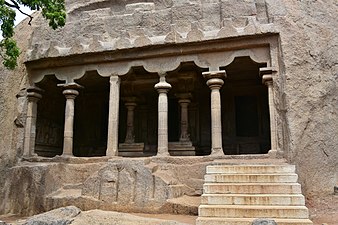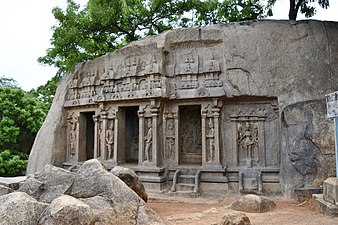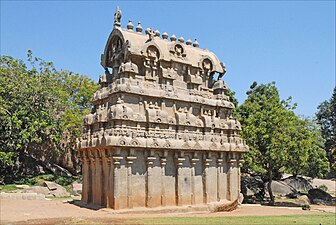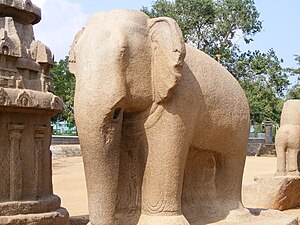Mahabalipuram Temple District
| Mahabalipuram Temple District | |
|---|---|
|
UNESCO world heritage |
|

|
|
|
Coastal temple |
|
| National territory: |
|
| Type: | Culture |
| Criteria : | (i) (ii) (iii) (vi) |
| Reference No .: | 249 |
| UNESCO region : | Asia and Pacific |
| History of enrollment | |
| Enrollment: | 1985 (session 9) |
Monuments at Mahabalipuram is one of the UNESCO -listed site of world heritage in India . The world heritage site includes various buildings and works of art from the Pallava period in Mamallapuram (Mahabalipuram) in the state of Tamil Nadu in southeast India.
background
The Pallava Empire was an important empire in southern India during its heyday in the 7th to 9th centuries. Its capital was Kanchipuram , its main port city Mamallapuram , also called Mahabalipuram. Both cities also formed important centers of Pallava architecture , which was one of the starting points for the later Dravida style in Indian temple architecture.
All preserved examples of Pallava architecture are sacred buildings, palace or residential buildings made of stone are not preserved. This suggests that these buildings were not built of stone, but of wood or clay. The sacred buildings of Mahabalipuram, together with those of Kanchipuram, are among the oldest preserved stone buildings in South India.
registration
Mahabalipuram Temple District was entered on the UNESCO World Heritage List in 1985 based on a resolution of the 9th session of the World Heritage Committee. The entry was made on the basis of criteria (i), (ii), (iii) and (vi).
(i): The bas-relief " Descent of the Ganga " is, like the one from Elephanta Island, a unique artistic achievement.
(ii): The influence of the sculptures of Mahabalipuram, characterized by the softness and suppleness of their modeling, reached far (Cambodia, Annam, Java).
(iii): Mahabalipuram is primarily a testimony to the Pallava civilization of Southeast India.
(vi): The sanctuary is one of the main centers of the Shiva cult.
scope
The world heritage site comprises several individual objects that are also listed as monuments by the Archaeological Survey of India . They can be divided into the following groups:
Rock temple
In Indian architecture, mandapa is the name for a columned hall that is open to the side. The mandapas of Mahabalipuram are rock temples with an open pillared hall, the walls of which are decorated with bas-reliefs. The world heritage includes:
- Dharmaraja Mandapa ( location )
- Koneri-Mandapa ( location ), five-cell Shiva temple
- Kotikal-Mandapa ( location )
- Krishna Mandapa ( location )
- Mahishasuramardini-Mandapa ( location )
- Panchapandava-Mandapa ( location )
- Ramanuja Mandapa ( location )
- Trimurti Temple ( location )
- Varaha-Mandapa ( location )
Free building temple
Outdoor temples are structures made of cut stones. The world heritage includes:
- Coastal temple ( location )
- Mukunda Nayanar Temple ( location )
- Olakkanesvara Temple ( location ), also known as "Old Lighthouse", built on the rock above the Mahishasuramardini-Mandapa, by the British as a lighthouse used
Rathas
Ratha is the name for the Indian temple chariot. In a figurative sense, this is the name given to small monolithic mock temples in Mahabalipuram that were carved out of individual blocks of diorite protruding from the sand . They represent stone rathas without wheels , so to speak . From the outside they look like free-standing individual structures, but most of them have no interior. The world heritage includes:
- the little temples known as the Five Rathas , including the four standing in a row like processional floats
- Draupadi-Ratha ( location ),
- Arjuna-Ratha ( location ),
- Bhima-Ratha ( location ),
- Dharmaraja-Ratha ( location )
- and the one next to this row
- Ganesha-Ratha ( location ),
- Pidari-Rathas ( location ), two unfinished Rathas standing next to each other,
- Valian-Kuttai-Ratha ( location ).
Rock art
The rock art in Mahabalipuram includes rock reliefs, i. H. Relief images carved out of "grown" rock , and sculptures carved out of individual boulders . The world heritage includes:
- Descent of the Ganga ( position ), also called penance of Arjuna , with 12 m high and 33 m wide one of the largest rock reliefs in the world.
- unfinished rock relief similar to the descent of the Ganga
- Group of elephants
- Animal figures at the five Rathas ( location )
- carved stone (Tiger Rock, Lage ) south of the coastal temple
- Mahishasura Rock ( location ) north of the coastal temple in the sea
literature
- Mahabalipuram Temple District . In: The World Heritage . Frederking & Thaler, Munich 2015, ISBN 978-3-95416-181-2 , pp. 204 .
- Mahabalipuram Temple District . In: The UNESCO World Heritage . Kunth Verlag, Munich 2017, ISBN 978-3-95504-413-8 , pp. 396 .
Web links
Individual evidence
- ↑ Official name English Group of Monuments at Mahabalipuram , French Ensemble de monuments de Mahabalipuram , German name according to the World Heritage List. In: www.unesco.de. German UNESCO Commission, accessed on February 1, 2018 .
- ^ A b Group of Monuments at Mahabalipuram. In: whc.unesco.org. UNESCO World Heritage Center, accessed February 1, 2018 .
- ↑ Decision: CONF 004 IX.A. In: whc.unesco.org. UNESCO World Heritage Center, accessed February 1, 2018 .
- ↑ a b ICOMOS : Ensemble de rronuments de Mahabalipuram / Group of Monuments at Mahabalipuram . Evaluation de l'organization consultative / Advisory Body Evaluation. 1984 (French, English, unesco.org [PDF]).
- ^ Alphabetical List of Monuments - Tamil Nadu. In: asi.nic.in. Archaeological Survey of India, accessed February 2, 2018 (monuments from Mamallapuram can be found under N-TN-C32 to N-TN-C64).













